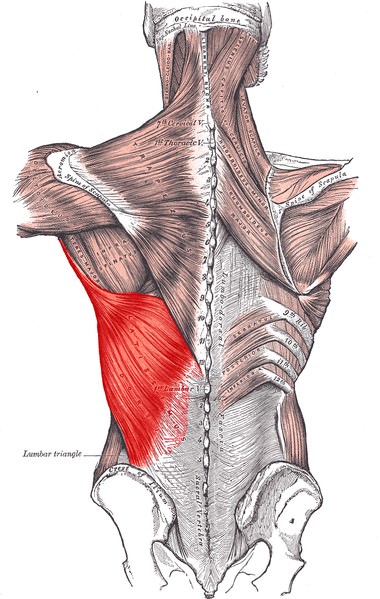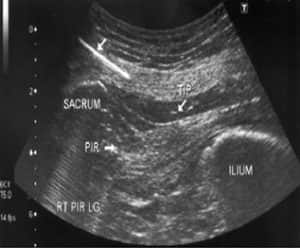Pain of myofascial origin
What is myofascial pain and what are its symptoms?
On many occasions, especially in patients with chronic back pain, the origin of the pain may be myofascial.
We define myofascial syndrome as pain whose origin is in the skeletal muscle and which has the following characteristics:
- Pain in a neighboring area, and referred to the affected muscle with a specific pattern for each muscle.
- Existence of trigger points (TP), a palpable and hyperirritable nodule located in a tense band of the muscle. When this point is stimulated, two characteristic phenomena occur: the appearance of referred pain and the production of an abrupt motor activity in the tense band.
- Shortening of the muscle fiber that will produce a restriction in the normal mobility of the muscle associated with adhesions between the muscle fasciae.
The muscles most frequently responsible for chronic pain are the trapezius, latissimus dorsi and thoracolumbar fascia, quadratus lumborum, piriformis muscle and psoas.
- Trapeze
It is the most important muscle of the cervical area, participating in the extension of the cervical and dorsal spine, and in the cervical lateralization movements, as well as in the extreme movements of the scapula and shoulder. Trapezius myofascial syndrome is common after traffic accidents with whiplash, and in post-surgical neck pain syndromes. It manifests with pain in the cervical area, often accompanied by occipital headache and contracture.
- latissimus dorsi and thoracolumbar fascia
It is the largest, widest and strongest muscle of the trunk. It is located posterior to the arm. It begins its insertions covered by the trapezium, at the apex of the spinous processes of the last thoracic vertebrae; continuing along the midline to the median sacral crest, and laterally, to the iliac crest and the external face of the four lower ribs. It is a muscle that allows adducting and rotating the arm as well as elevating the trunk and at the same time the last four ribs.

It also participates in the stabilization of the pelvis and in the extension of the dorsolumbar spine together with the erector spinae muscle (with which it has continuity thanks to the thoracolumbar fascia), which is why a myofascial syndrome of the latissimus dorsi is often identified in chronic dorsalgias.
- Square lumbar
Myofascial syndrome of the quadratus lumborum muscle is one of the most frequent causes of low back pain of muscular origin. It is the muscle that plays a major role in the maintenance of upright posture, and contributes to the extension and lateralization movements of the lumbar spine. The quadratus lumborum muscle originates in the iliolumbar ligament and iliac crest, and inserts in the transverse processes.
- Piriformis muscle
Muscle capable of giving referred pain in the lumbar area and in the back of the thigh. It is a small muscle located deep within the hip and gluteal region. It has its insertions in the sacrum (the lowest region of the spine), and in the femur (thigh bone). Its primary function is the external rotation of the hip.
Myofascial syndrome of the piriformis or piriformis is usually caused by a contracture or spasm, which irritates the sciatic nerve as it passes underneath.
Its contracture causes pain in the gluteal region and may even result in referred pain in the posterior and distal thigh. Patients often report deep pain from the hip to the buttocks.
- Psoas
It is a muscle that participates little in lumbar mobility; its main function is hip flexion. However, as they originate in the lateral aspect of the lumbar vertebrae and discs, their contracture can produce lumbar pain. As it is deep, it is only accessible by palpation in the insertion area, and in its course through the abdomen, places where we can find active trigger points.
What are the treatments for myofascial spine pain?
The treatment of myofascial pain begins with the localization of the painful muscle based on the patient’s clinical history and physical examination.
The goal of treatment in myofascial syndrome is inactivation of the trigger points and elongation of the muscle to its normal length.
Classical myofascial treatment consists of physiotherapy techniques (such as intermittent cold stretching), associated with pharmacotherapy of chronic pain (analgesics and psychotropic drugs).
Multiple useful rehabilitative procedures have been described: from massages (deep gliding with friction, compression) to stretching associated with myofascial release techniques.
 Various types of electrotherapies (ultrasound, TENS, interferential currents, repetitive magnetic stimulation, galvanization, laser, iontophoresis) have also been applied with modest results.
Various types of electrotherapies (ultrasound, TENS, interferential currents, repetitive magnetic stimulation, galvanization, laser, iontophoresis) have also been applied with modest results.
When conservative treatment has failed, the possibility of mitigating pain by infiltration of the trigger point associated with a blockade of the muscle fasciae is a valid therapeutic alternative in appropriately selected patients.
From the Rehabilitation Medicine and Complementary Therapies Unit at Barcelona Spine Institute we offer our patients the most appropriate personalized treatment. Do not hesitate to contact your specialist and request an appointment.
